As a business specialist or manager, you are majorly responsible for important business decisions. Therefore, it is necessary to understand and know how to create a well-structured case. A business case is a fundamental document that plays a significant role in the organization’s decision-making processes. It is advisable to use a template when creating such a case. The template will act as a complete and comprehensive guide during the creation process. Hence, this article will discuss the template’s benefits and essential components for preparing it.
What is a Business Case?
A business case is a document that justifies why an organization invested in a particular project, investment, program, or initiative.
This document evaluates the project’s risks, costs, benefits, and alternatives. Additionally, it provides a coherent framework in which you can evaluate the company’s financial and operational viability to boost the success rates of its projects. It is usually prepared by the project manager, business analyst, or an important stakeholder.
The document is presented to organizational executives, shareholders, and other interested parties who will either approve, revise, or reject the proposed investment of the project. Furthermore, it summarizes the essential elements of the initiative in question. These elements enable the investors, executives, and shareholders to measure the project’s benefits to the organization. That means that for you to have a complete document, your case should comprehensively outline the importance and value of the project.
Free Templates
Following are the templates that you can download for free:
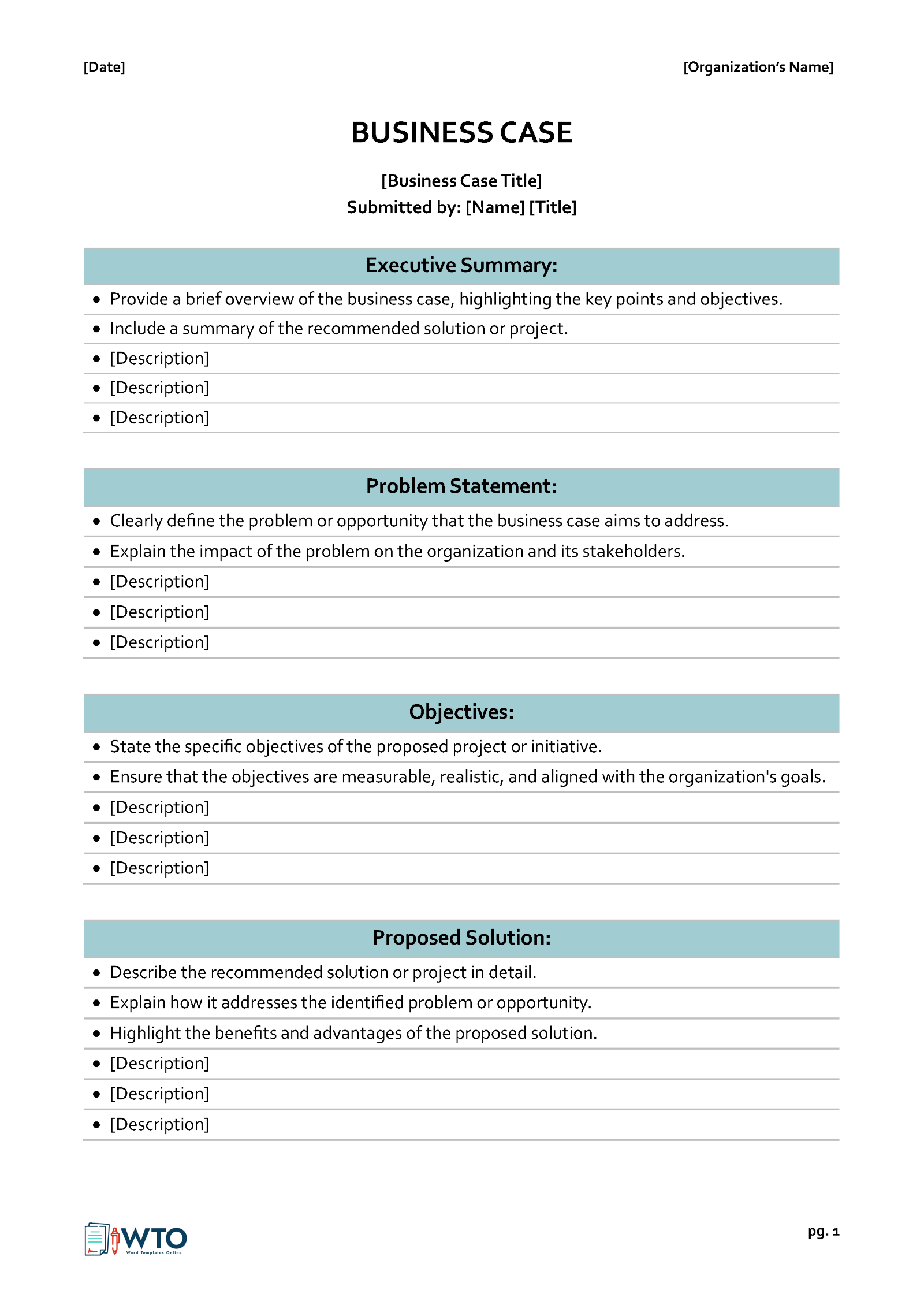
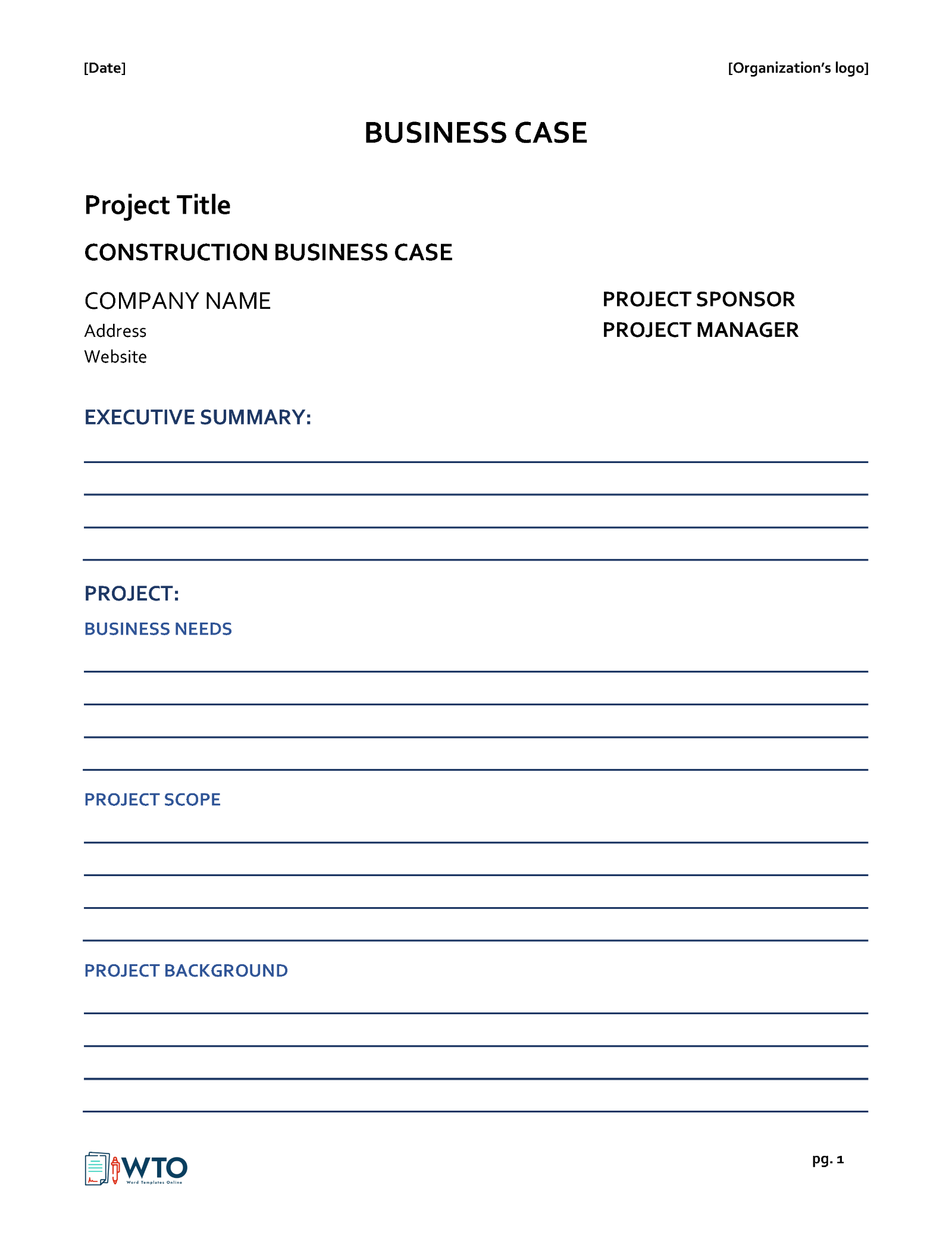
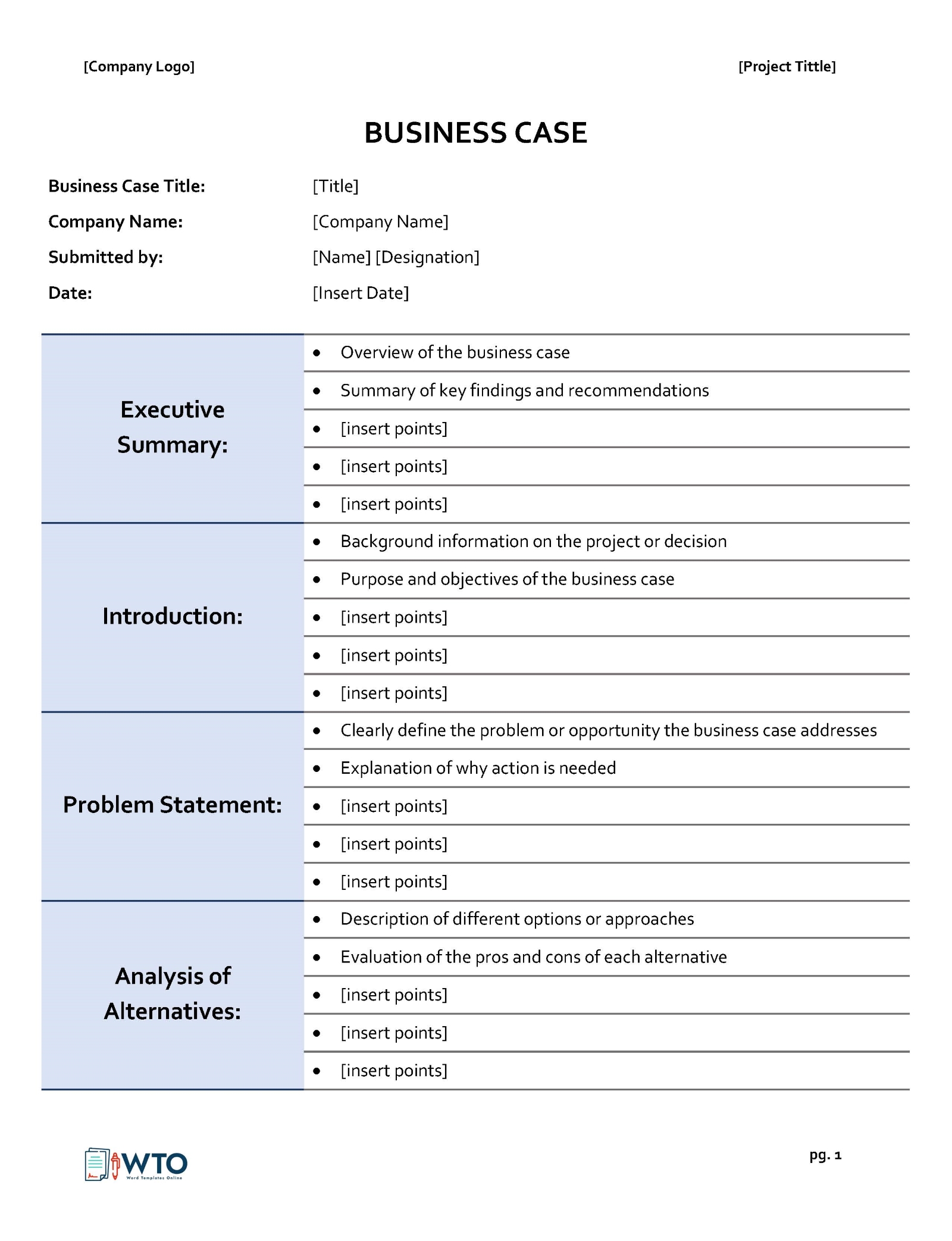
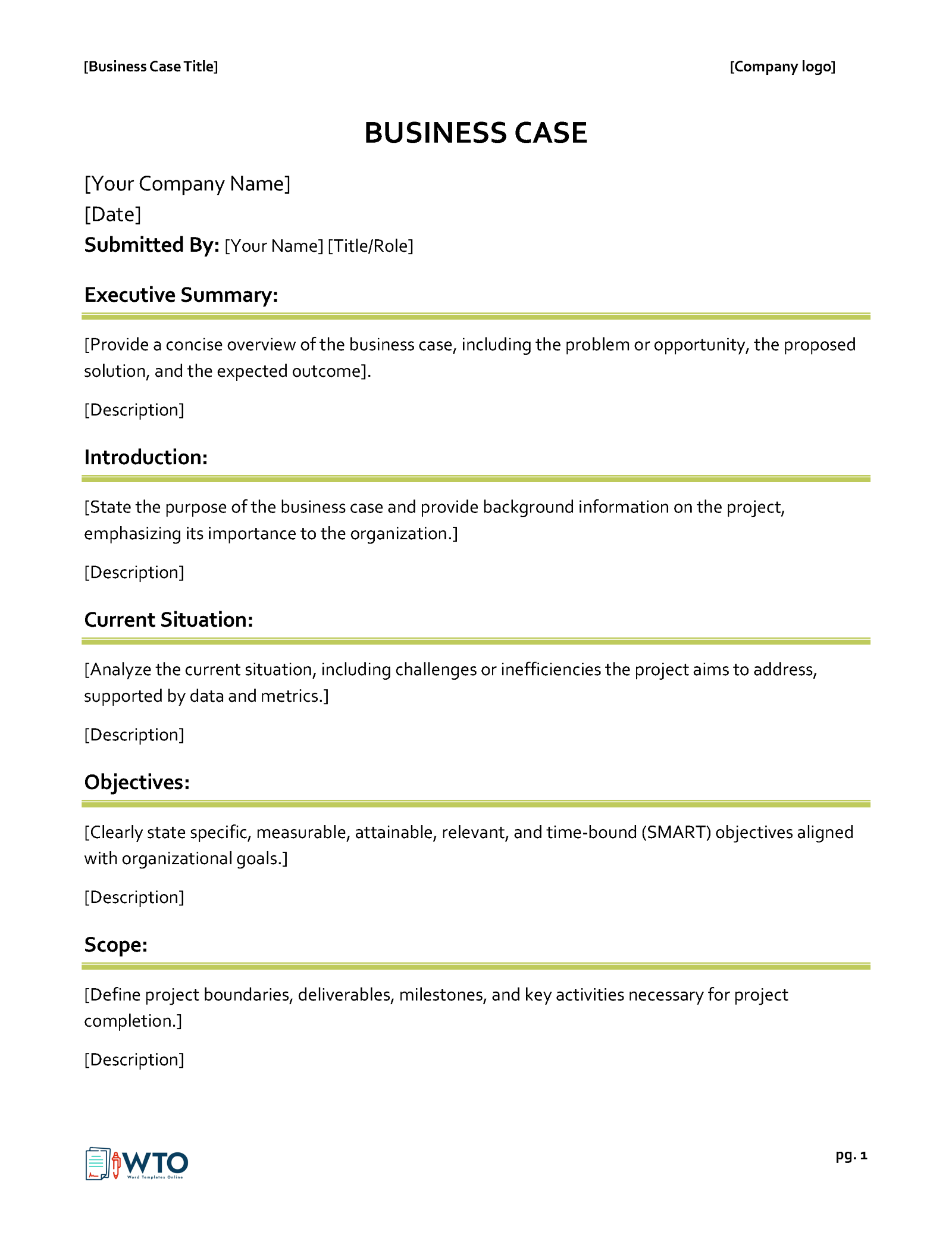
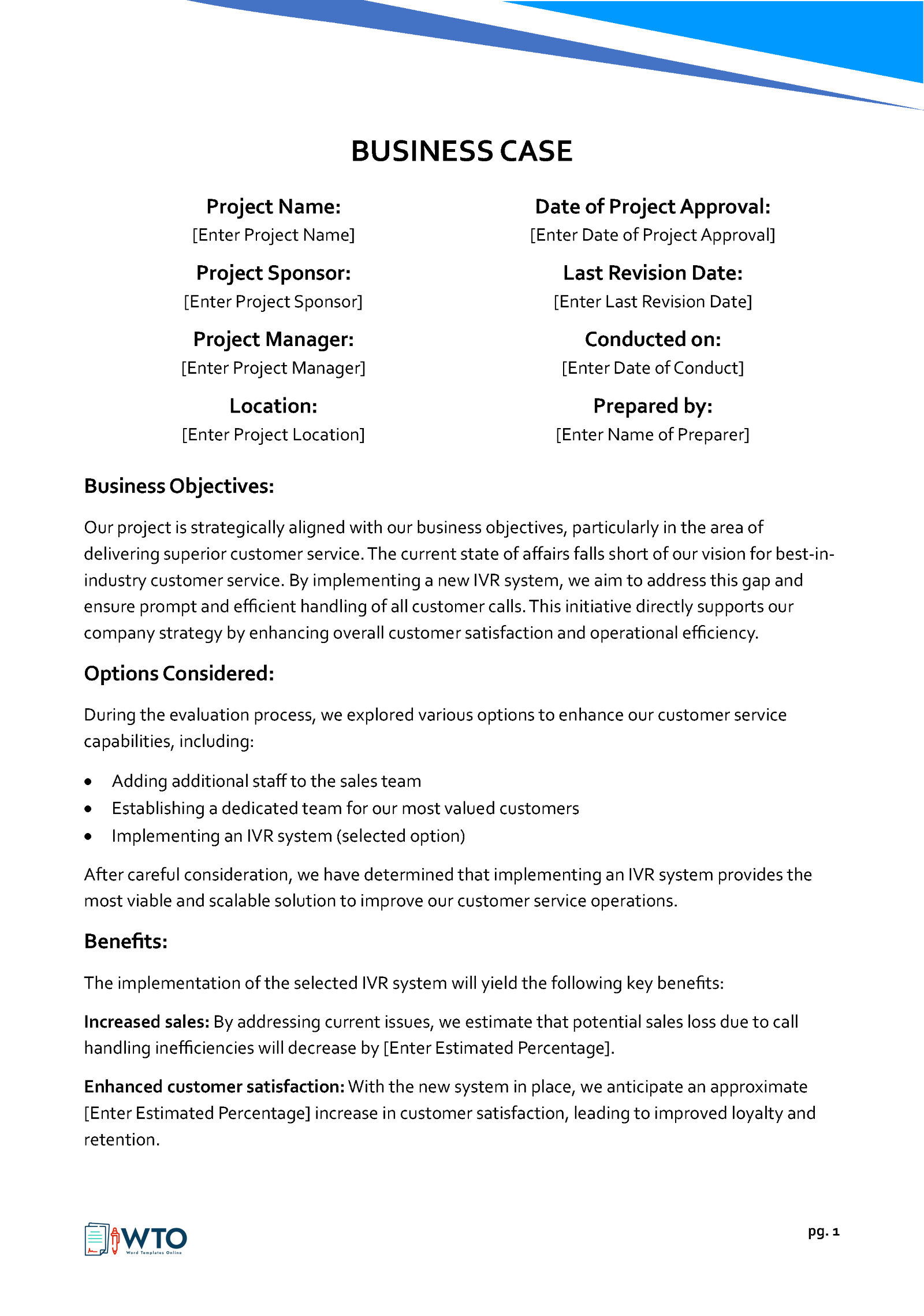
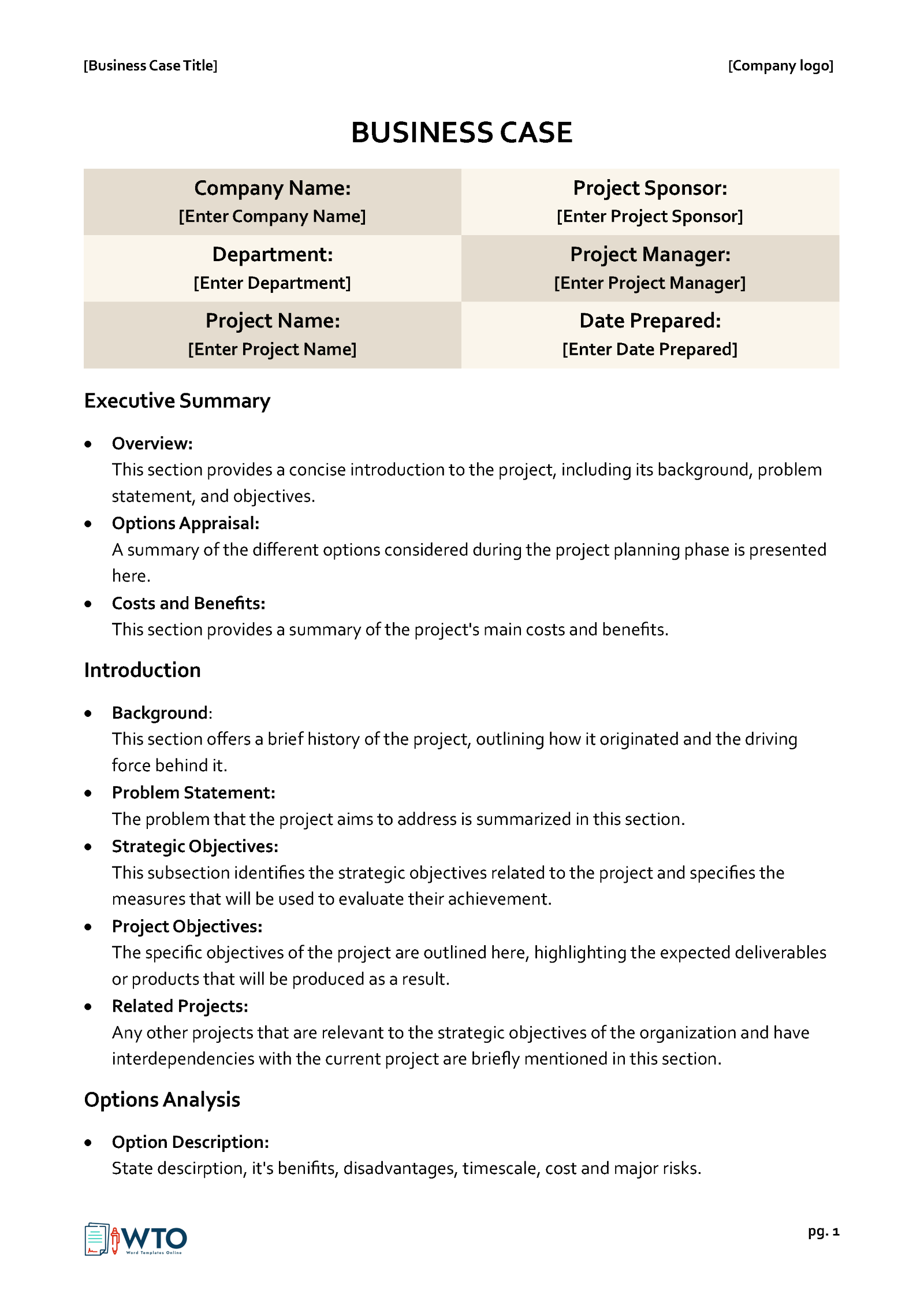
Benefits of Business Case Template
A template for business case is a structured document that provides a blueprint and a format for creating the case.
This document acts as a guide on how to organize and present the information contained in your case. Furthermore, it outlines the fundamental elements to consider when crafting a business case.
The following are the benefits of using business case template:
Alignment with organizational standards
The template ensures that the proposed initiatives and projects are aligned with the company’s overall strategic goals and practices. Additionally, it guarantees that the information is presented accurately and consistently. As a result, your presentation will adhere to the organizational guidelines for creating it. Also, it will ensure that the executives and stakeholders understand the initiative or the project you are proposing.
Improved communication
Communication is critical in any business set-up. This document will ensure that key points and other relevant details are clearly and concisely articulated. As a result, this will facilitate improved communication between the stakeholders and other reverent individuals. Improved communication will allow the executives to understand the proposed project’s benefits, costs, and risks.
Enhance collaboration
This structured document will provide a shared framework for individuals, departments, and shareholders to collaborate when creating a standardized business case. With collaboration, the initiative’s final proposal will capture the different perspectives of all involved parties.
Training and onboarding
A template for business case can be an effective and efficient training and onboarding tool for new and old employees. By using a standardized template, employees can learn how to create a perfect document that meets the organizational guidelines. The templates provide employees with a step-by-step guide on how to craft it. Also, they enable employees to create it that meets organizational standards and guidelines.
Flexibility for customization
Template for business case can be customized to satisfy the requirements and adhere to the organization’s guidelines. While the template offers a standardized structure, it can also be modified to accommodate different project proposals that have unique requirements. This flexibility allows an organization to maintain consistency when preparing and presenting business cases to stakeholders and investors.
Continuous improvement
You can regularly review and update it to ensure it remains practical and relevant to the organizational objectives. That means, using the feedback gathered from the stakeholders, you can continuously improve your case. The feedback will highlight the areas that need improvement during the preparation process. Therefore, your document will remain effective as the organization evolves.
How to Choose the Right Template
Choosing a suitable template is essential to effectively present a project proposal to investors and stakeholders. With a well-structured document, you can design the case with organized data and present the information clearly and concisely.
The following are steps to follow when choosing a template:
Step 1: Identify the specific needs and requirements of your project
Before choosing a template, you consider the type of project, its objectives, the target audience, the scope, and the objectives of the project. This will help you to identify the information to be included. For instance, if you are creating a business case for launching a new product, you will need a template that contains sections like risk analysis, financial projections, and marketing research. Therefore, by understanding your project, you can choose a template that complements the specific needs of your project.
Step 2: Evaluate different template options
It is important to evaluate and examine different business case templates to determine which one meets the requirements of your project. Note that the template should be user-friendly and easy to customize. Therefore, you can select and evaluate different templates after identifying the needs and requirements of the project in question. While evaluating the template, you should consider its structure, usability, and overall layout.
In addition, the template should help you to maintain the structure and the integrity of the project information. Therefore, you should be able to customize and tailor the selected template to fit and satisfy the specific needs of your project.
Step 3: Consider industry standards and best practices
It is fundamental to select and use templates that are widely used and accepted in the industry. Templates that meet the industry standards and practices will ensure that your project proposal adheres to the industry norms, standards, and best practices. Therefore, you should select templates with sections such as shareholder analysis, risk and benefit assessment, and market analysis. A template that adheres to industry standards and best practices will make your business case credible and acceptable among clients, executives, and investors.
Basic Components of a Template
Templates may vary depending on the specifications of the project in question. However, there are essential elements that must be included in the template.
They include the following:
Executive summary
The summary should be placed at the beginning of the case. This section prides investors and executives with a brief overview of the entire project. The executive summary outlines the purpose of the project, its objectives, the problems being solved, and the potential benefits the project will bring.
Business problem
In this section, indicate and explain the problem or opportunity to be resolved by the proposed project. Therefore, this section should identify the existing problems and why the proposed project is necessary to solve the identified problem. Also, it should explain why the project is vital to the organization.
Possible solutions
This section will allow you to list and evaluate the possible business solutions to the identified problem. The possible solutions will demonstrate how the project will be executed and each proposed solution’s expected pros and cons. This will allow stakeholders to select solutions that will offer more benefits to the organization.
Product or service
This section of the template describes the product or service that will be developed as part of the solution to the identified problem. Therefore, you will describe the product or service, its features, the development process, its benefits, and the product or service that will satisfy the market demand.
Project definition
This section provides a detailed definition and description of the project. Project definition entails outlining the specific objectives of the project, the expected outcome, and the possible challenges and limitations to be faced during the project. It also describes how the proposed project aligns with the organization’s strategic mission.
Project plan
This section offers a breakdown of how the project will be handled. Therefore, this section outlines the tasks, resources, activities, and the timeline needed to complete the project. A project plan provides shareholders with a blueprint of how the project will be executed and managed and the expected outcome.
Project scope
Project scope defines the project’s boundaries and indicates what it will and will not include. This component highlights and manages the expectations of the project and ensures that the established boundaries are not violated or neglected.
Project budget
The project budget allows investors to understand the financial implications of the proposed initiative. Therefore, this section provides a breakdown of the finances needed to make the project successful. This component includes providing an estimate of the cost of the materials, hiring labor, equipment, and any other necessary expenses.
Project roadmap
This component provides a detailed analysis and overview of the project’s timeline and milestones in business. It presents a breakdown of how the project will proceed from start to finish. It allows investors and executives to visualize and understand the project’s milestones, critical dependencies, and timeline.
Project financials
This section provides a detailed analysis of the project’s financial projections. This may include return on investment (ROI), revenue, expenses, and costs. It measures the financial benefits and the practicality of the project. Therefore, stakeholders can use this section to evaluate the economic appeal of the project.
Market assessment
This section analyzes the current market trend, conditions, and competitiveness in the market regarding the proposed product or service. The assessment will indicate the target audience, their needs, the competitive landscape, and the market size. Marker assessment will help stakeholders to understand how the market works and the possible benefits and risks of undertaking the project.
Market strategy
The market strategy highlights the marketing strategies and tactics that will be used to reach the target audience and promote the proposed product or service. This strategy will be used to gain a marketing advantage over the competitors. Additionally, the market strategy will give investors insights into achieving success in a crowded market.
Risk assessment
Risk assessment allows executives and shareholders to understand the risks associated with the project and how they can be regulated. This segment identifies and evaluates the potential risks and reservations connected with the proposed project. The assessment indicates and explains how the identified risks may hinder and affect the company’s strategic plans and the project’s progress.
Project stakeholders
This section of the template indicates the key stakeholders, groups, or individuals affected by the project directly. The stakeholders may include investors, partners, employees, and customers. These individuals play a vital role in the project cycle by ensuring that there are strategies to mitigate any risks and ensure the project is successful. Also, the project is usually designed to meet and satisfy the demands and expectations of these individuals.
Business Case Vs. Business Plan
A business case is a document a project manager prepares to justify the investment in a particular initiative or opportunity. The document outlines the benefits and the potential outcome of the project in question. It also shows the financial needs of the proposed project, the risks of pursuing this opportunity, and an assessment of available alternatives to the proposed initiative.
On the other hand, a business plan is a document that expansively highlights an organization’s mission, strategies, and operational procedures. It indicates a company’s products, services, operations, marketing, and financial projections. A plan can be used to secure funding from investors and other financial institutions. In addition, it can be used for financial development and decision-making within the organization.
Final Thoughts
A perfectly prepared business case is an instrumental tool that can be used to grow a business and help maintain its advantage in a constantly evolving and competitive market. The essence of the template is to help the organization prepare a detailed document that will help them gain financial aid to complete its project objectives. Therefore, it allows the organization to easily align its projects with the right resources and strategies to attain the desired outcomes. In addition, it offers structure and consistency that makes the decision-making process easy, accurate, and fast.




